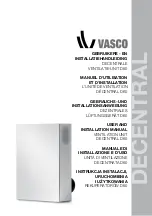
507640-05
Page 17 of 25
Issue 2245
4. Slide the gas valve switch to the “ON” position and
initiate a call for heat. If manifold pressure must be
adjusted, remove cap from pressure regulator and
turn adjustment screw clockwise to increase pressure
or counterclockwise to reduce pressure.
5.
After checking pressure, turn gas off, remove
manometer fitting, and replace pipe plug and regulator
cap.
6. Put furnace in operation and check plug for leaks
using soapy solution.
Burner and Burner Orifice Instructions
To check or change burners or burner orifices:
1.
Close the main manual gas shutoff valve and turn
off all power to unit.
2. Remove the burner access panel.
3. Disconnect the union in the gas supply line upstream
of the gas valve and downstream of the manual shutoff
valve.
4. Label wires going to the gas valve, then disconnect
the wires.
5.
To change orifice:
a. Remove screws that fasten the manifold to the
burner box assembly and remove the manifold.
b.
Remove the orifices, then install replacement
orifices.
c. To reassemble: Reverse above steps, making
sure orifices are inserted into the orifice holders
on the back end of the burners, and that burners
are level and centered on each burner opening in
the vest panel.
6. To remove or service burners:
a. Label and disconnect the wires to the rollout
switch and disconnect the igniter and flame
sensor leads at the ignition control.
b. Remove the screws that secure the burner box
assembly to the vest panel and remove the
assembly from the unit.
c. Remove the screws that fasten the burner rack
and bottom shield assembly to the burner box.
Burners are now accessible for removal.
d. To Reassemble: Reverse above steps.
7. After reassembly of all parts is complete and all wires
are reconnected, open the main manual gas shutoff
valve; check for and correct any gas leaks. Turn
electrical power on, initiate a call for heat, and check
for proper burner operation.
8. Install burner access panel.
Crankcase Heater (if used)
Some models may be equipped with a crankcase heater
to prevent excessive migration of liquid refrigerant into the
compressor during off cycles. Power must be maintained
to the unit to keep this feature active.
Except as required for safety while servicing,
do not open
the system disconnect switch.
Sequence of Operation
Blower Control
Units are equipped with a variable speed motor that is
capable of maintaining a specified CFM throughout the
external static range. A particular CFM can be obtained by
positioning jumpers (COOL, HEAT, and ADJUST) on the
blower control. The HEAT and COOL jumpers are labeled
A, B, C and D. Each of the numbers corresponds with an
air volume (CFM) setting. The ADJUST jumper is labeled
Test, -, +, and Norm. The + and - pin settings are used to
add or subtract a percentage of the CFM selected. The
Test jumper is used to operate the motor in the test mode.
Figure 9 shows the blower control.
Figure 8.









































